Building a new ‘woodland’ teaching area.
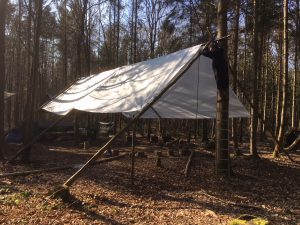
We’ve been lucky enough to have been residents in a beautiful 100 acre woodland in Ashford, Kent called March Woods for about a year now. My name is Craig Fordham and I run a company called Black Wolf Survival and I’ve been in the outdoor industry on and off for about 20 years mainly specialising in Bushcraft & Survival. Aside from running sessions for schools, groups and individuals I am also a brand ambassador for Craghoppers clothing and write a few articles for various magazines.
Our basecamp teaching site at March Woods was functional and basic, we’d initially cleared a large enough area to erect a 32ft parachute as a main teaching area and a couple of other tarps we utilise for a kitchen area etc. 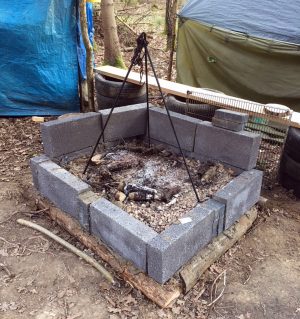 Parachutes are great and very popular, they look the part and are quite inexpensive but anyone who’s used them will also know that they aren’t that waterproof and can turn into a bit of a sail in strong winds. Demand for the sessions that we run, especially woodland-themed birthday parties and day courses has really increased over the past 12 months as we knew that ideally we needed a more secure and waterproof shelter area from where we could teach from.
Parachutes are great and very popular, they look the part and are quite inexpensive but anyone who’s used them will also know that they aren’t that waterproof and can turn into a bit of a sail in strong winds. Demand for the sessions that we run, especially woodland-themed birthday parties and day courses has really increased over the past 12 months as we knew that ideally we needed a more secure and waterproof shelter area from where we could teach from.
Our idea was to build a large A frame shelter from green wood and cover it with a suitably large tarpaulin, pulled tight to give us a large dry working space. Our first job was to speak to the woodland manager (Ian) and land owner (Angus) to explain what we wanted to do and to ask permission to cut a number of large Ash poles that we could use to make the frame. Thankfully they both thought it was a good idea and gave me the go ahead so we called in our good friend and fellow instructor Jack to help us. Jack had recently passed his various chainsaw and cutting exams and was keen to put his learning into practice.
In our cleared area we have two oak trees that are approximately 12 metres apart, and our idea was to cut a long ridge pole that would stretch between the two trees. We would lift and secure the pole to the two Oak trees to create a ridge pole at a height of about 4 metres or so and then cut six long Ash poles with a Y piece at the end of them that would lock, in pairs, under the ridge pole and support it as well as give it a frame.
We went off into the woods armed with chainsaw and tape measure and quickly identified a number of Ash trees that would give us suitable Y poles and a ridge pole. Jack donned all his suitable PPE and did his thing with the chainsaw whilst I stayed at a safe distance and observed.
The ridge pole had a diameter of about 6” and was around 14 metres long and the six Y poles were each about 12” thick and a good 6 metres long. Just selecting the right trees, cutting them, trimming them and cleaning up the stumps etc. took the best part of a day so we pulled the various poles to the edges of the pathway and called it a day.
We had a run of parties and courses for a week so not a lot happened for a while until one Saturday when I was away but Jack and my other instructor Sean were in site and were able to pull all the poles into one central location a few hundred metres away from our camp area. I was told at the time that I might be in for a shock on just how heavy some of these poles were….
Sean and I had allocated a week in which we thought we could work every day and get the shelter built, along with a few other improvements we had planned for base camp before we had a number of people booked in for a walking staff & stick carving day on Sunday 25th February.
Sean and I had been chatting for some time, discussing ideas and we decided that even though we already owned a large, heavy duty 10m x 12m tarpaulin we were actually going to buy a clear tarp that measured 9m x 7m. We decided that was more than big enough for our needs and a clear tarp would allow more light inside than a dark green and brown one. We were a little concerned that I might create a “greenhouse” effect and become too hot in summer but the reality was that the other trees around the camp provide a decent amount of shade already, the tarp had a good UV filter in it and the layout of it would allow plenty of ventilation. Plus we had another idea of how we could add a little extra shade and a cool effect but we’ll come to that later.
The tarp was an EBay bargain at £62.99. It’s a 150 gsm tarp but its design and construction meant that it was as strong as a 250 gsm tarp, so all in all we thought it was the perfect choice.
Job number one was to carry the new 14m long ridge pole down to the cleared area where we would be putting it up, Sean was right, I had a shock when I lifted the pole, I had faith in my design but I knew that this week was going to be quite a mission for two guys without any industrial lifting equipment or machinery, the top path to my camp area is also very muddy at the moment so carrying these heavy long poles whilst slipping around in deep mud just added to the fun and games really.
A long Ash pole like this was never going to be completely straight and smooth so once we had carried it back to camp the first thing we did was saw off any little side branches and use a draw knife and an axe to take off any noticeable lumps and bumps. There was still a small concern that the tarp would wear through where it rubbed against the top of the pole so we cut up a few old cheap foam camping mats I had lying around in my garage and taped them over the pole using duct tape to give it some padding and hopefully prevent excessive wear and tear.
Initially we thought that we could life the ridgepole into place using a ladder, secured to a tree and then holding it in place whilst someone lashed it to the tree. It was obvious that the pole was just too heavy for this so instead we used a couple of old climbing ropes I had and threw them over the crook of two high branches on the oak trees at either end of the pole and used a simple pulley system to hoist up the ridge pole until it was at the correct height we needed and then I helped it into place whilst Sean climbed the ladder, reached up and tied it securely against the Oak tree using a good square lashing. We repeated this at the other end and it meant we now had our ridge pole secured in place at just the right height we wanted.
We had deliberately left the Y ended poles long so we could cut them to size as we lifted them into place. The ground isn’t totally even and we wanted to be able to support the ridge pole and level it out bit along its length. We started with the two ends and cut the Y pieces so they would snugly fit the ridge pole and then used the existing climbing ropes at either end to hoist up one pole at a time while Sean lashed them in place from the ladder.
The poles are so heavy it was a real mission to pull them up high enough and manoeuvre them into position but a little effort meant we had the outside four side poles all locked in place by the end of the day.
We sighted the ridgepole until we were happy it was level and trimmed the end of the Y poles so that it all sat nice and square, the cut ends of the poles had a quick coat of preservative and then they were slightly sunk into holes we had dug to help hold everything secure.
We had deliberately left the two middle Y poles long so we could use the extra length to take any sag out of the ridge pole, we also knew that securing them into place would be a lot more awkward as we couldn’t lean the ladder against the main trees at the end so we ended up wedging the ladder against one of the Y poles and tying it to the frame, it may have looked a little risky but both Sean and I had been on the ladder with a combined weight of about 30 stone and hadn’t managed to make it slip so we were happy it was safe to use.
We also had to trim the ends of the middle two Y poles so that nothing would stick up and rub against the tarpaulin when it was run over the frame. It was time to pull the tarp over the frame and see how it all looked. Also it meant we could square up the frame a little if it needed it so the tarp was even all the way round.
We knew we’d have a gap all around the edge of the tarp between it and the frame and that we would lace it to the frame and stretch it out. Being very aware that it was a large tarp we thought about the effect of strong winds and decided that we would use bungee rope to lash the tarp with, giving it a certain amount of “suspension”. We’d also measured so that the bottom end of the tarp would be about head height as well so wind would pass underneath it easily as well.
On the vertical edges we pulled bungee balls through the eyelets and then used climbing rope to lace it around the poles and pull it tight. For the horizontal edges we cut another couple of long poles and lashed them to the main frame and then used bungee rope to go from the eyelets on the tarp to the beams and pull the whole thing tight. We also lashed in a horizontal cross brace between the two middle Y poles to give more rigidity and also give us something to hang a lantern off in the evenings. To stop the bungee rope ripping through the eyelets on the tarp we pulled a loop through each one and placed a small stick in the loop, this distributes the pull more evenly and will hopefully help prevent the cord ripping through the eyelets.
So, pretty much we were there and just wanted to add a few finishing touches, one of these was to cut six smaller Y poles that we bedded into place at an angle against the larger Y poles. This really firmed everything up and pretty much eliminated any movement from the frame.
We also threw an old camo net over the tarp so see the effect it had and loved it. From a distance now the section of the A frame with the camo net on it just disappears but from underneath it still allows plenty of light in, so we shall be buying another couple of camo nets to cover more of the main tarp.
All in all we love it and it will provide us with a much needed weatherproof teaching area. I’m sure we shall tinker and improve things as we go along but already the group who used it on Sunday loved it. It was a hard week and Sean and I are aching but it was well worth it.
[Below is a series of images of the site / construction].
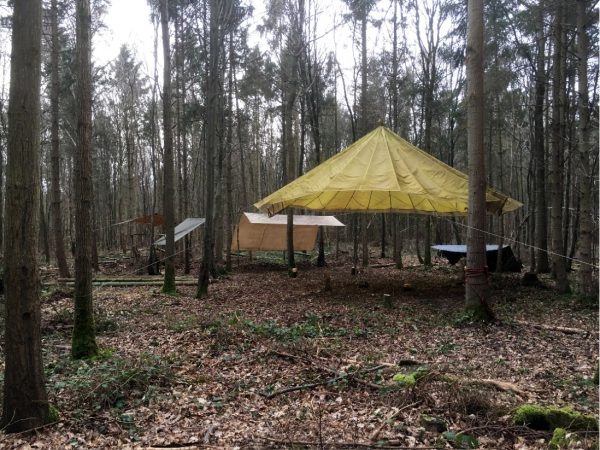
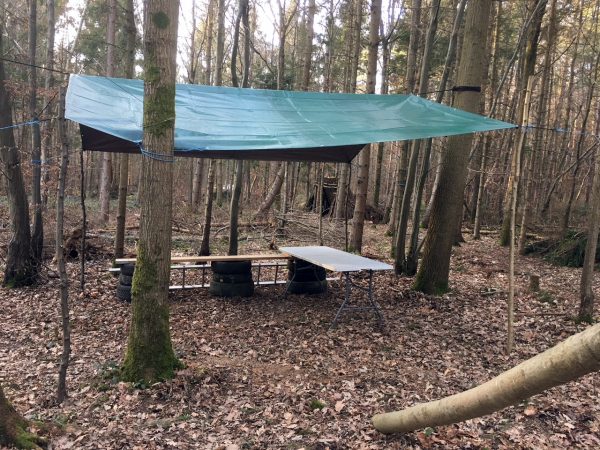
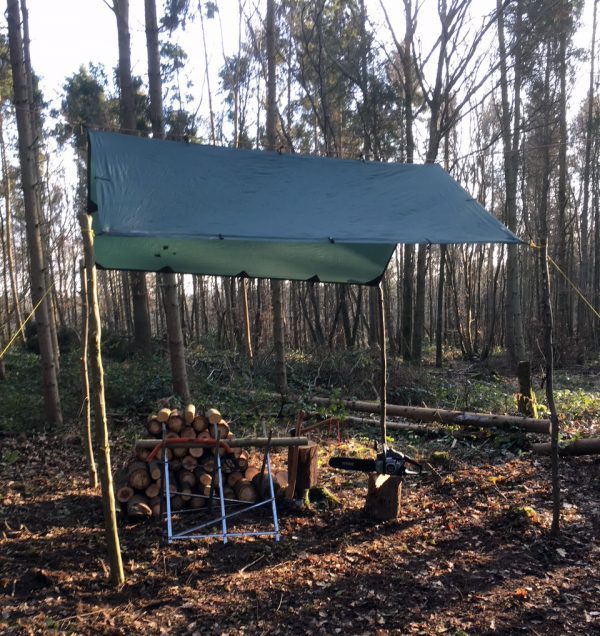
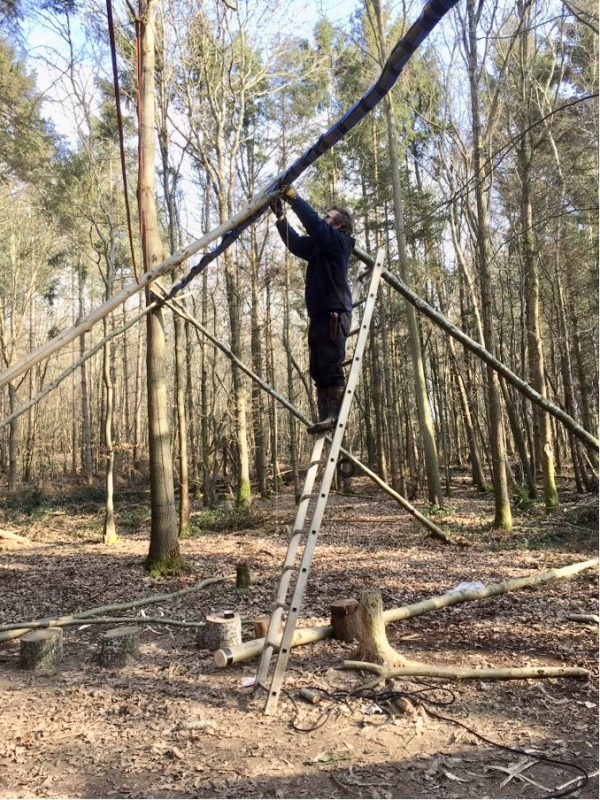
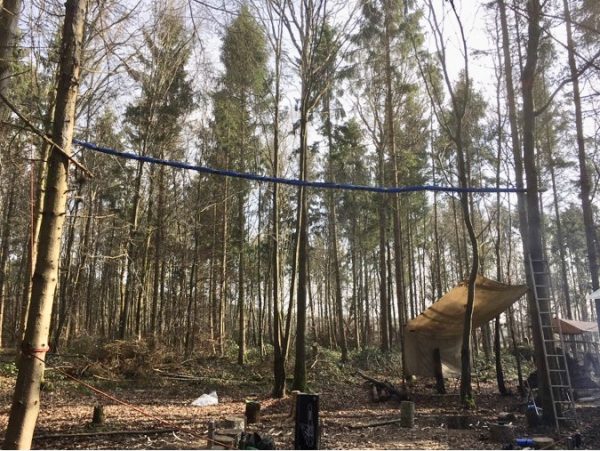
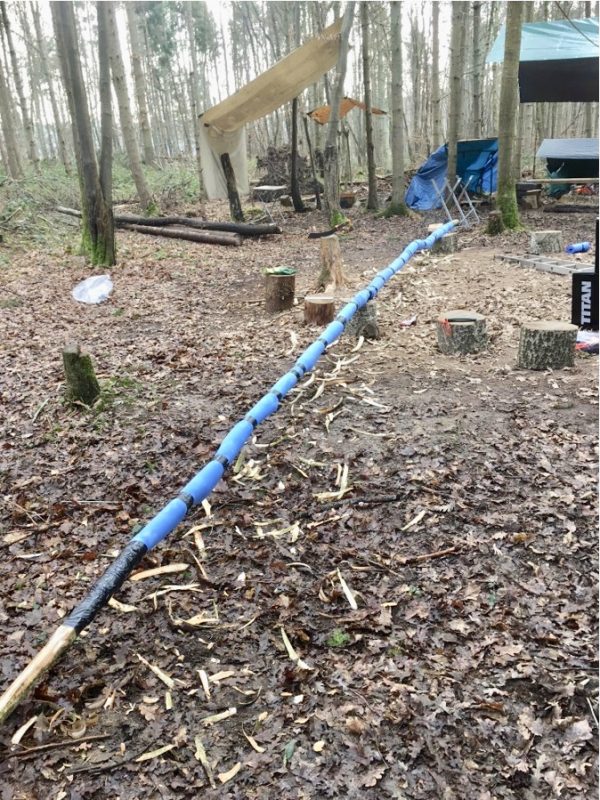
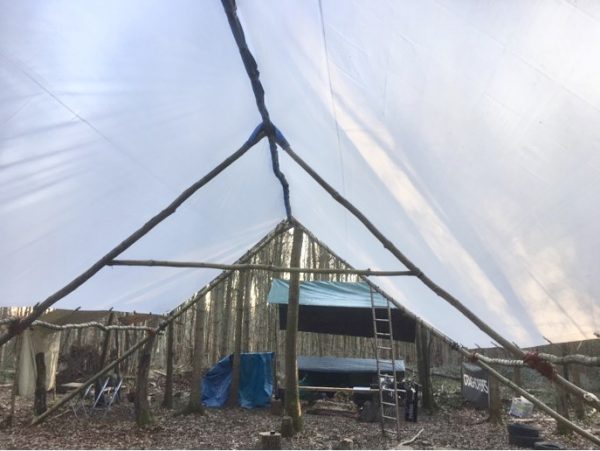
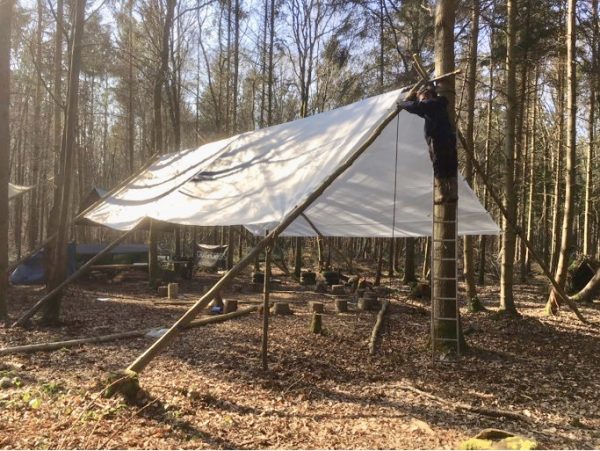
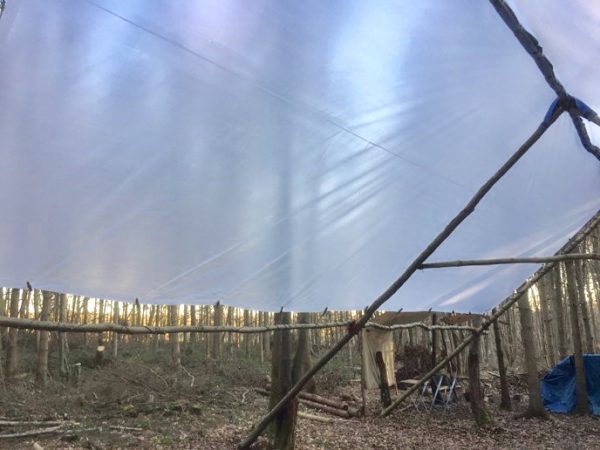
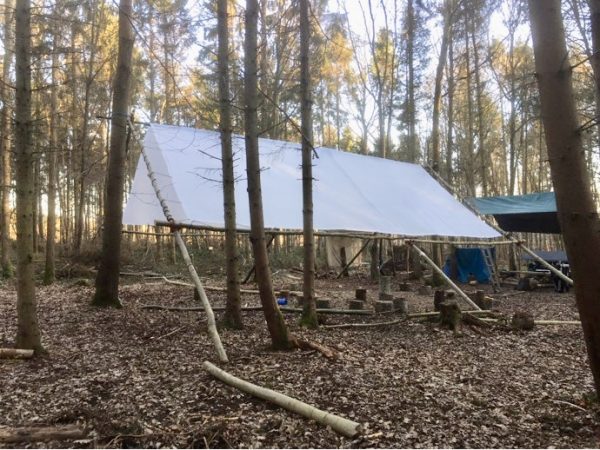
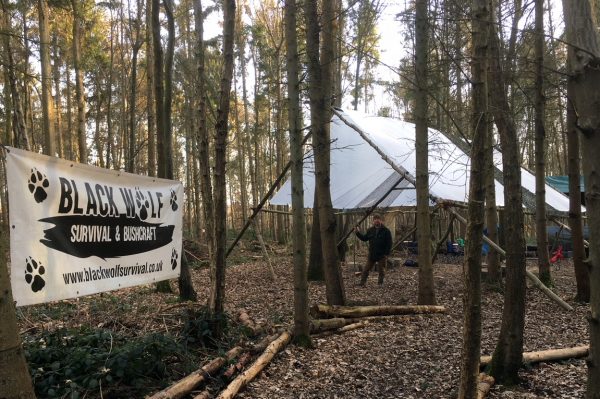
Comments are closed for this post.

Inspirational, great story, well told. Wish we had something similar and close to my Scout Troop.
PAUL BROWNE
18 June, 2019